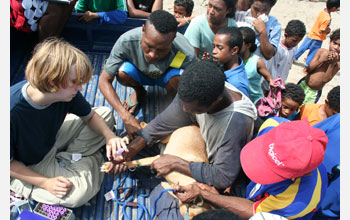Multimedia Gallery
Mapping Genetic Origins of Stray Dogs (Image 1)
Researchers take a blood sample from a dog in the back of a pick-up truck mobbed by interested Papuans. The samples were used in a study mapping the genetic origins of stray dogs in order to learn more about dog domestication and evolutionary genomics. (Date of Image: June-September 2009) [Image 1 of 3 related images. See Image 2.]
More about this Image
A collaboration of researchers is studying dog genetics and evolution. The collaboration includes Carlos Bustamante, a professor of genetics at Stanford University School of Medicine; Robert Wayne, professor of ecology and evolutionary biology at the University of California, Los Angeles (UCLA); and Elaine Ostrander, chief and senior investigator, cancer and genetics branch of the National Human Genome Research Institute. The scientists believe that studying village dogs--semi-feral dogs, or "strays"--can provide important new information about dog domestication and evolutionary genomics.
Bustamante, whose group at Stanford is mapping the genetic origins of village dogs, says, "If we think about dogs, they live in different types of worlds. Breed dogs, we keep in our homes. Wolves live in the wild and are subject to natural selection. Then you have village dogs that are somewhere in between. They have undergone some degree of adaptive change, living near humans--but still are subject to natural selection the way wolves are. So by studying them, we can get a much better picture of the evolutionary process."
In 2010, the UCLA researchers released a study--supported by the National Science Foundation (NSF)--that showed the origins of most breed dogs can be traced back to wolves from the Middle East, rather than wolves from Asia or Europe, as was previously thought. The UCLA team also created the first evolutionary tree of dog breeds, that showed a structure suggesting new breeds were developed from crosses within specific breed groups that share particular traits. But while these studies focused on breed dogs--which are very important in identifying genetic differences among breeds--there was still a missing piece of the genetic puzzle: village dogs.
In order to genotype stray dogs from around the globe, Bustamante--the lead on the project--sought the help of numerous researchers (including Ryan Boyko and his wife Cori), shelters and veterinarians from around the world to help find and sample dogs.
The Boykos and a research team helped collect blood samples from more than 1,200 stray dogs in dozens of countries and five continents over a 2-year period. Part of the process involved communicating with local residents in order to find dogs living in the community and also with local shelters, so that samples could be drawn from dogs that had been brought in from neighboring areas. Shelters were visited in Egypt, Papua New Guinea, Qatar, Lebanon, Puerto Rico, Indonesia, India and across Turkey. At times they found it necessary to partake in local customs to put villagers at ease with testing their dogs and to gain cooperation. Sometimes, members of the local community were hired as assistants to help. For safety reasons the dogs were muzzled, then weighed, measured and photographed, after which 3 to 5 milliliters of blood was drawn for analysis. In one instance near the border of Syria, the Boykos tested large dogs belonging to shepherds, who were not used to handling. After DNA analyses, they discovered that one of the dogs was actually a full-blooded wolf!
In addition to turning dogs into a model species in evolutionary genomics, the research--which is funded by NSF as part of the American Recovery and Reinvestment Act of 2009--will also "answer important questions about how domestication and adaptation to human environments have shaped the dog genome prior to the advent of modern artificial selection toward breed standards," says Adam Boyko, who is with the Stanford group and is the brother of Ryan.
The researchers are examining common genetic markers among the street dogs and comparing them to wolves and breed dogs. They also are sequencing the genome and "will build demographic models to compare the genomes of the village dogs to the wolves and the domestic dogs to see what's unique and shared, and what you see only in breed dogs," Bustamante says.
The scientists believe this information will provide valuable insight into both dog genetics and human genetics as well. Bustamante says, "Understanding the dog genome helps us understand the human genome. It helps us understand human traits. Dogs are the most phenotypically diverse species--if humans varied as much as dogs, we'd have 2-feet-tall humans--and 20-feet-tall humans." [Research supported by NSF grant DEB 09-48510.]
Credit: Ryan Boyko
Images and other media in the National Science Foundation Multimedia Gallery are available for use in print and electronic material by NSF employees, members of the media, university staff, teachers and the general public. All media in the gallery are intended for personal, educational and nonprofit/non-commercial use only.
Images credited to the National Science Foundation, a federal agency, are in the public domain. The images were created by employees of the United States Government as part of their official duties or prepared by contractors as "works for hire" for NSF. You may freely use NSF-credited images and, at your discretion, credit NSF with a "Courtesy: National Science Foundation" notation.
Additional information about general usage can be found in Conditions.
Also Available:
Download the high-resolution JPG version of the image. (5.6 MB)
Use your mouse to right-click (Mac users may need to Ctrl-click) the link above and choose the option that will save the file or target to your computer.



